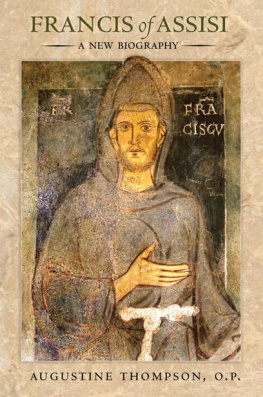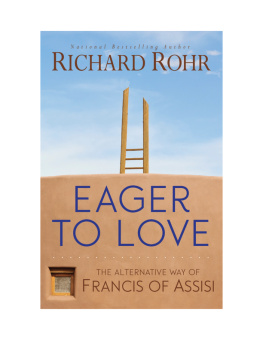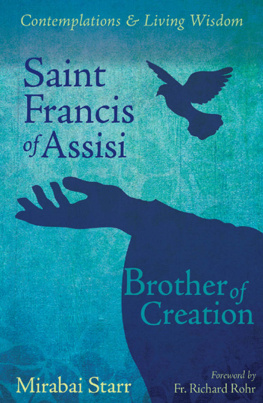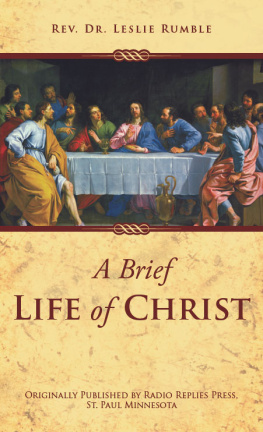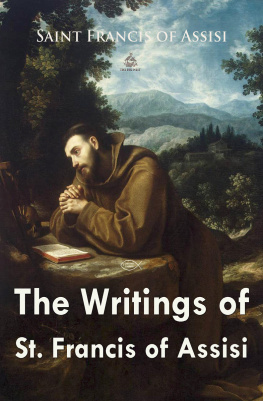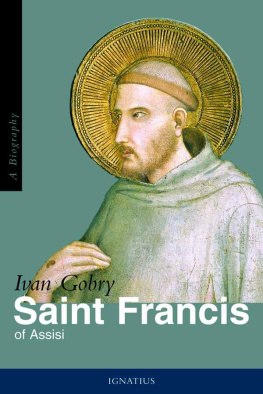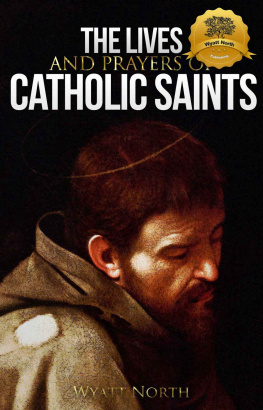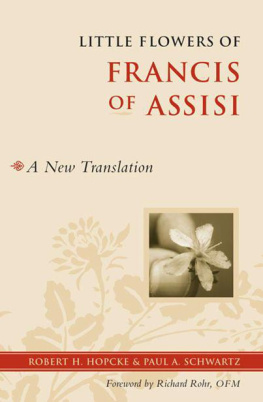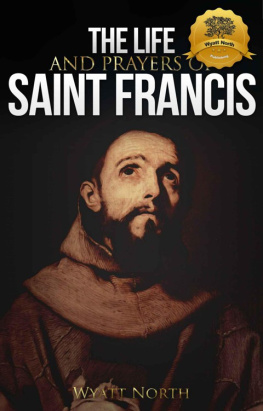
FRANCIS OF ASSISI
A New Biography

[ A UGUSTINE T HOMPSON , O.P. ]
C ORNELL U NIVERSITY P RESS
I THACA AND L ONDON
[ CONTENTS ]
Introduction
PART I
The Life
1. When I Was in My Sins, 11811205
2. The Penitent from Assisi, 12061209
3. The Primitive Fraternity, 12091215
4. Expansion and Consolidation, 12161220
5. Francis Returns Home, 12201221
6. Rules and Retirement, 12211223
7. The Way of the Cross, 12231225
8. From Penitent to Saint, 12251226
For Further Reading
PART II
Sources and Debates
Preliminary Note
List of Abbreviations
On the Franciscan Question
On Chapter 1
On Chapter 2
On Chapter 3
On Chapter 4
On Chapter 5
On Chapter 6
On Chapter 7
On Chapter 8
Bibliography
[ INTRODUCTION ]
THIS BOOK IS subtitled A New Biography, by which I mean not just a recent biography, but one that also presents a new portrait of the man known as Saint Francis of Assisi. We are fortunate to have a great mass of stories, anecdotes, reports, and writings about Francis dating from his own century, most of which scholars now consider in some or all respects legendary. This life is the first sustained attempt in English to treat these medieval sources for Francis in a consistently, sometimes ruthlessly, critical manner. The goal is to reveal, as much as we can, the man behind the legends.
With one notable exceptionthe Italian Francis scholar Raoul Mansellieven academic writers on Francis seem to rely on the same set of stories mostly put together in the same way. Or, after Manselli, they do not go much beyond his reconstructions. Sometimes they even claim that it is impossible to find the man behind the legends. Popular writers, on the other hand, give different spins to Franciss life as a whole but usually repeat events in it as if their historical truth were obvious. Or, at best, they label them legendary, without attempting to find the historical reality behind them.
In writing this book, I have asked a series of questions about the evidence we have for Francis. First, who wrote the text? Was it Francis, someone who knew him, or someone who just heard about him? Oddly, many popular biographies favor hearsay stories over Franciss own writings. Next, when was the document written? I have great doubts about whether we can trust reports composed over two generations after Franciss death, and for which we have no earlier evidence. This is especially the case with miracle stories, not because I do not think miracles happen, but because Francis was a canonized saint, and for medieval people, adding more miracles to his biography was not fraud, but an act of homage and piety. The famous Wolf of Gubbio failed that test. On the other hand, Franciss life would be incomplete without the popular perception of miraculous power that surrounded his person after he became a living saint in his later years. Above all, I have been highly skeptical of any story in which Francis is made the mouthpiece for a party involved in some debate within his order years after his death, especially stories on the Franciscan practice of poverty.
This reading of the sources for Francis has resulted in a number of divergences from the usual story. The Francis I have come to know has proved a more complex and personally conflicted man than the saint of the legends. It is, I think, misleading to assimilate him to some stereotyped image of holiness, especially one that suggests that a saint never has crises of faith, is never angry or depressed, never passes judgments, and never becomes frustrated with himself or others. Franciss very humanity makes him, I think, more impressive and challenging than a saint who embodied that (impossible) kind of holiness. I would also emphasize that my Historical Francis is no more the real Francis than the Francis of the legends and popular biographies. He is historical in that the picture I have painted is the result of historical method, not theological reflection or pious edification. That said, I do think that my Francis is closer to the man known by his thirteenth-century contemporaries than the figure we find in the modern biographies I have read. I do hope that my portrait reveals a Francis that will provide stimulus for new theological reflection and for richer Christian piety.
I came to Francis as something of an outsider. As a historian, I was new to the contentious and often bitter world of academic controversy over the Historical Francis. Especially for his modern followers, the Franciscan friars, nuns, sisters, and lay tertiaries, how one imagines Francis and his concerns has powerful, sometimes highly divisive, implications for living ones life today. I have no personal stake in those internal Franciscan debates. As Americans colloquially say, I dont have a dog in that fight.
But I must also be forthcoming. Although I write principally as a historian, I am also a Catholic Christian, a priest, and a member of the Order of Preachers, the Dominicans, who are often considered the twin of Franciss own Friars Minor. I admit that I never had much devotion to Saint Francis, and I always found it mildly amusing that we Dominicans refer to him as Our Holy Father Francis, using the title Father, which he went out of his way to avoid. As I have worked on this biography, my respect for Francis and for his vision has increased, and I hope that this book will speak to modern people, believers and unbelievers alike, and that the Francis I have come to know will have something to say to them today.
Some readers of this book will be scholars, perhaps Franciscans, who have spent years studying the Middle Ages, the Order of Friars Minor, or its founder. They will have questions about methods and sources; for those readers I have provided commentaries on each chapter in part 2 of this book, Sources and Debates. These explain the decisions that lie behind my narrative. The section of Sources and Debates titled On the Franciscan Question answers some questions that all readers might have about the scholarly debates, which are usually characterized as the Search for the Historical Francis and have now lasted over one hundred years. Specialists will want to read all these commentary sections systematically, probably along with the life. Other readers will want to look into these comments only occasionally, when they wonder about why I describe incidents of Franciss life the way I do. Readers who want to consult the commentary sections will find page references there that correspond to the text of the life.
If readers are in their fifties, as I am, they may have been introduced to Francis by Franco Zefferellis film Brother Sun, Sister Moon, the last and perhaps greatest monument in a line of romantic interpretations going back over a hundred years. In this story, Francis was a free spirit, a wild religious genius, a kind of medieval hippie, misunderstood and then exploited by the medieval Church. Or perhaps they know him as the man who spoke to animals, a nature mystic, an ecologist, a pacifist, a feminist, a voice for our time. For others, he is the little plaster man on the birdbath, the most charming and nonthreatening of Catholic saints. Like Jesus, Francis belongs to everyone, and so everyone, or almost everyone, has his or her own Francis. And this is probably the way it has to be.
In years of teaching, I have often been astounded at how unhappy students can be when they encounter a different Francis from the one they expect. Oddly enough, the most painful moment usually comes when they discover that Saint Francis did not write the Peace Prayer of Saint Francisa popular hymn best known by its opening words Make me a channel of your peace, and sung to a tune written by the Anglican composer Sebastian Temple. Many are quite shocked to find that this song is not identical to Franciss Canticle of Brother Sun, from which Zefferelli took the name of his movie. The Peace Prayer is modern and anonymous, originally written in French, and dates to about 1912, when it was published in a minor French spiritual magazine, La Clochette. Noble as its sentiments are, Francis would not have written such a piece, focused as it is on the self, with its constant repetition of the pronouns I and me, the words God and Jesus never appearing once. There are a good number of other stories that will not appear here either, Francis and the Wolf of Gubbio being perhaps the most famous. Nor will Franciss supposed encounter with Saint Dominican omission that very much annoys a number of my Dominican brothers who have read my drafts or discussed this work with me. We all have our own Francis.
Next page
